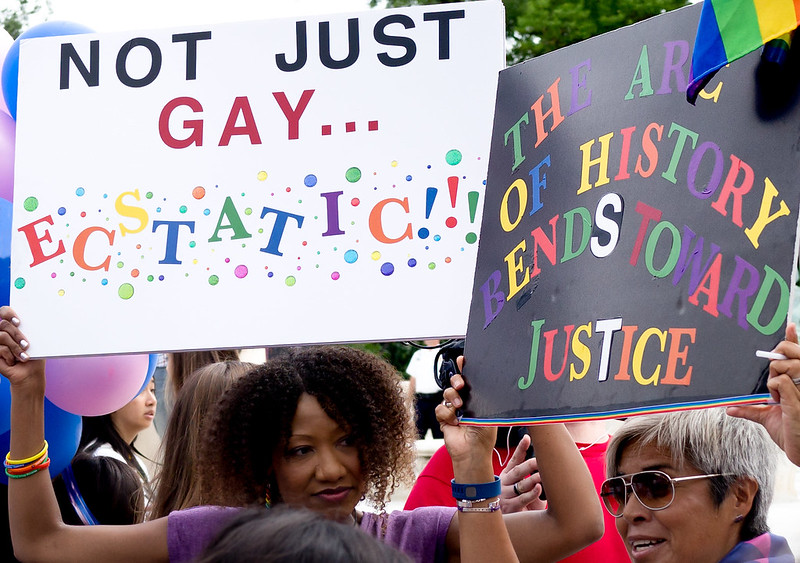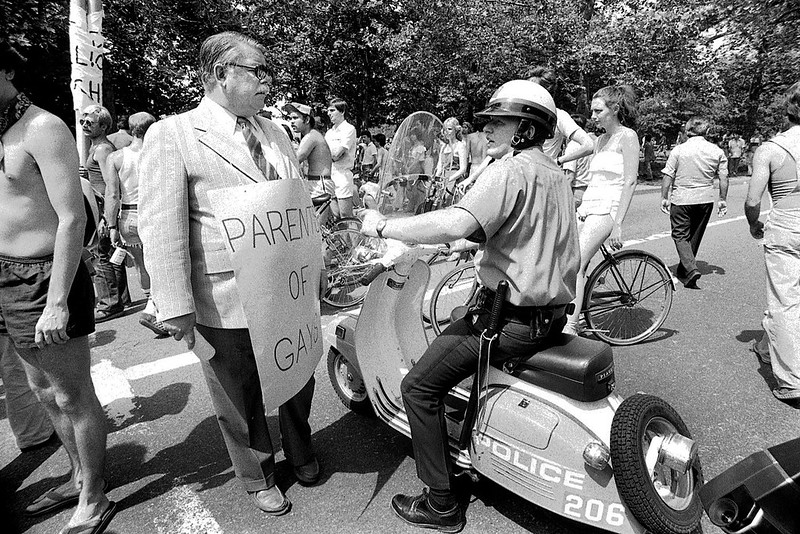
I can still remember exactly where I was when I found out same-sex marriage had been legalized—sitting at the kitchen table of my childhood home with my cup of tea, a newly-out 17-year-old with dip-dyed hair, a teenage product of the Obama years.
Looking at the news report on my phone screen felt like the opening of a door—for me and for a lot of the LGBTQ community I knew at the time. After the Obergefell v. Hodges decision, same-sex marriage exploded, and it seemed everyone was getting married—some for the second or third time, some even though they’d been together for decades, some even though they hadn’t believed in marriage.
The excitement I felt that summer was reflected in the streets: Millions turned out for Pride celebrations across the U.S. that June.
But then came 2016, and the advent of the Trump administration—and in subsequent years, increasing legal attacks on LGBTQ rights.
Soon, my community and I began to wonder: What did this Supreme Court victory actually mean for LGBTQ people in the U.S.?
Even today, in a country where trans women of color face disproportionate rates of violence, including violence at the hands of the very systems that are supposed to protect them, what is the significance of this Supreme Court ruling?
While Obergefell v. Hodges represented an indisputable victory for LGBTQ legal rights in the U.S., it’s important to consider that for any marginalized group, progress doesn’t come just through acceptance by legal institutions—and acceptance by legal institutions doesn’t necessarily translate to cultural acceptance.
In fact, a lot of the progress that our community has fought viciously for happened outside of courtrooms. It happened in the streets. It happened in Compton’s cafeteria and at the Stonewall Inn. And it was led by people who didn’t look a whole lot like the plaintiffs of Obergefell v. Hodges.
In recent years, it has manifested in protests at Pride events against the presence of police departments and corporations. And it is in the spirit of this legacy of protest that a multitude of LGBTQ organizations have come out in support of the Black Lives Matter protests this June.
Legal victories are often seen as the most important road to acceptance in progressive movements that gain mainstream attention—but they cannot be the only path through which we fight for our rights.
For one, look at all the other cases related to gay rights that have come before the courts since the 2015 decision—the wedding cake case and the most recent decision on employment discrimination, to name a couple. (And those are just the ones that have good outcomes: Countless cases and policies over the past few years have proved that trans people don’t have equal rights in the U.S.)
These cases show that the battle for LGBTQ rights includes fighting for much more than the right to a legally defined category of personal relationship—it means fighting for active anti-discrimination legislation that protects us at work and in the world. They also show that court decisions, while an important path of advocacy, don’t make discrimination go away.
What’s more, acceptance through legal channels usually means progress only for the members of the movement who are considered “acceptable” by mainstream society. There’s a reason why plaintiffs in LGBTQ civil rights cases are white, cisgender gay couples—because they’re perceived as being the least threatening to the white heteropatriarchy. It can be argued that this investment in respectability has contributed to the mainstreaming of the gay rights movement. And while having our concerns get mainstream attention is good, it’s important to think about who’s left out of these narratives.
Earlier this month, the Trump administration rolled back health care discrimination protections implemented under the Obama administration, effectively allowing healthcare providers to discriminate against trans people. The decision was announced on the fourth anniversary of the Pulse nightclub shooting, in which nearly 50 young, predominantly LGBTQ people of color, were murdered at a club in Orlando, Fla.
This, along with the rapidly rising count of LGBTQ people of color who’ve been killed this year, prove we still have so much to protest in 2020.
And we must interrogate what “acceptance” really entails—because if it just means assimilation to a society that is still discriminatory, should we really be celebrating? As the popular rallying cry goes, “the first Pride was a riot”—a riot led by LGBTQ people who knew that this country’s legal systems weren’t built for them, and that they’d have to advocate for their own humanity themselves.

The necessity of protest, particularly in the current cultural moment, is acknowledged by leaders of the mainstream movement for LGBTQ rights.
Sarah Kate Ellis, president of GLAAD, told Good Morning America:
“We know that social change is often built on the pain and outrage of moments like the ones we are seeing in America today. It is important to remember that the revolutionary riots at Stonewall in 1969 were spearheaded by many LGBTQ people of color, and that none of the progress made for the acceptance and equality of LGBTQ people over the past 51 years would be possible if not for the action and courage of those protestors.”
And lawyers involved with the recent Supreme Court ruling against discrimination of LGBTQ people at work acknowledged the importance of protest in making the landmark decision possible:
On the fifth anniversary of Obergefell v. Hodges, we should celebrate the gains we’ve made—because we’ve come so far, and we deserve to celebrate that.
But we should be careful to not let decisions like this make us complacent. The fight is still going on, in the streets and in the courtrooms— and none of us are free till all of us are.





